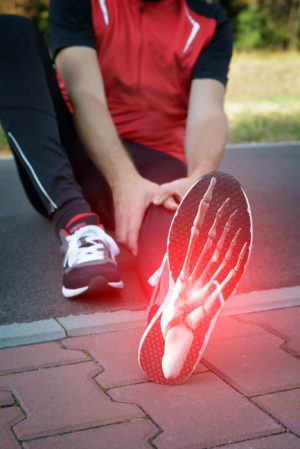 Fall is here, and although the weather doesn’t exactly feel like it, cooler temperatures will be here in no time. Since it’s officially fall, we thought we could do a themed post that took a closer look at foot injuries from a different type of fall – falls from a great height. So today, we share three types of foot injuries that commonly occur as the result of a fall.
Fall is here, and although the weather doesn’t exactly feel like it, cooler temperatures will be here in no time. Since it’s officially fall, we thought we could do a themed post that took a closer look at foot injuries from a different type of fall – falls from a great height. So today, we share three types of foot injuries that commonly occur as the result of a fall.
Foot Injuries and Falls
Whether you’re up on a ladder cleaning leaves out of the gutter or simply miss a step and fall down the stairs, here’s a look at three common injuries we see in our office that are a result of falls.
1. Foot Fractures – A foot fracture is probably the most common type of injury we see from falls. It’s not uncommon for our feet to be the first thing that hits the ground when we fall off a ladder or from a great height, which means our feet and all the tiny bones that make up our feet take the brunt of the force. When this happens, it doesn’t take much for one or more of the bones to become overstressed and fracture as a result. Foot fractures are generally treated with rest, ice, compression and elevation, as well as crutches or a walking boot to help with weight bearing. Most foot fractures heal without surgery, but if the fracture jeopardizes the blood supply to the area or it’s unlikely that the fracture will heal correctly on its own, an operation may be necessary.
2. Lisfranc Injuries – The Lisfranc injury actually got its name from the doctor who treated many soldiers in Napolean’s army who suffered the injury. The soldiers would suffer a Lisfranc injury when they’d fall off their horse and their leg would get caught in the stirrup, subjecting the foot high trauma and a twisting motion. The injury occurs when the midfoot is twisted when the foot is plantar-flexed, so while you won’t experience this injury during an unimpeded fall, you may suffer the injury if your foot gets caught or twisted during your fall.
3. Joint Dislocations – Your foot is comprised of 26 bones and 33 joints, so it’s no surprise that a high energy injury like a fall can lead to joint dislocation. The dislocation can take place in your forefoot, your midfoot or your hindfoot depending on how force is distributed across your foot during the fall. A foot joint dislocation is often categorized by acute pain and swelling that doesn’t subside after a few days, and there may be some visible deformity. A doctor can easily spot the dislocation with the help of imaging tests and walk you through your best treatment options.
So if you’ve suffered a fall injury, or you just want help figuring out what’s causing your foot pain, reach out to Dr. Silverman in the contact box below.